Neuro 2.2 - brodmann and cerebrum stuff
1/55
There's no tags or description
Looks like no tags are added yet.
Name | Mastery | Learn | Test | Matching | Spaced |
|---|
No study sessions yet.
56 Terms
4
what is the broadmann’s area for the primary motor cortex (m1)
primary
does the primary or secondary motor cortex control movement of the distal muscles
pre
is the primary motor cortex in the pre or post central gyrus
VL
the subcortical afferents of the primary cortex goes from the cerebellum → (specific area of thalamus) → M1
VPL
the subcortical afferents of the primary cortex goes from the somatic sensory → (specific area of thalamus) → M1
premotor
does the premotor or primary or secondary motor cortex initiate the phases of movements
premotor
does the premotor or primary or secondary motor cortex have fewer connections to the thalamus
VA/VL
the secondary and premotor motor areas receive subcortical afferents that go from the globus pallidus and substantia nigra → (specific area of thalamus) → SMA (secondary motor area)
3, 1, 2
what is the broadmann’s area for the primary somatosensory area
post
is the primary somatosensory area in the pre or post central gyrus
VPL and VPM
the somatosensory area has major afferent signals which go from ascending snesory pathways → (specific area of thalamus) → S1
secondary
does the primary or secondary somatosensory area process more pain information
left
is the right or left hemisphere usually the dominanry side (language area)
non-dominant
dominant or non-dominant hemisphere:
visual-spatial analysis and spatial attention to bilateral space
dominant
dominant or non-dominant hemisphere:
Arithmetic: sequential and analytical calculating skills
non-dominant
dominant or non-dominant hemisphere:
Arithmetic: ability to line up columns of numbers on page
non-dominant
dominant or non-dominant hemisphere:
•3-D recognition
•recognition of faces
dominant
dominant or non-dominant hemisphere:
Visual-spatial analysis and spatial attention – contralateral space only
dominant
dominant or non-dominant hemisphere:
Sense of Direction: following a set of written directions in sequence
non-dominant
dominant or non-dominant hemisphere:
Sense of Direction: Finding one’s way by overall sense of spatial orientation
dominant
dominant or non-dominant hemisphere:
analytic thinking
non-dominant
dominant or non-dominant hemisphere:
intuitive thought
dominant
dominant or non-dominant hemisphere:
decisions/problem solving based on analytical data
non-dominant
dominant or non-dominant hemisphere:
creative/artistic abilities
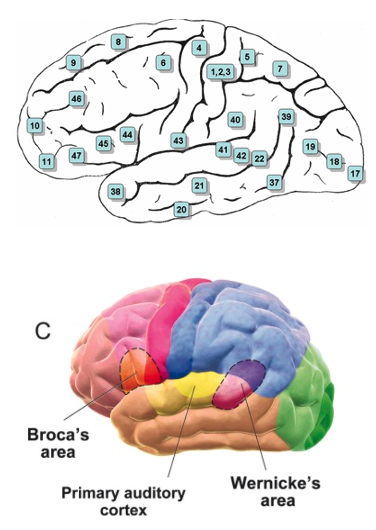
41 and 42
what is the broadmann’s area for the primary auditory area
difficult interpreting or localing sound but not deafness
what would happen with a lesion to the primary auditory area
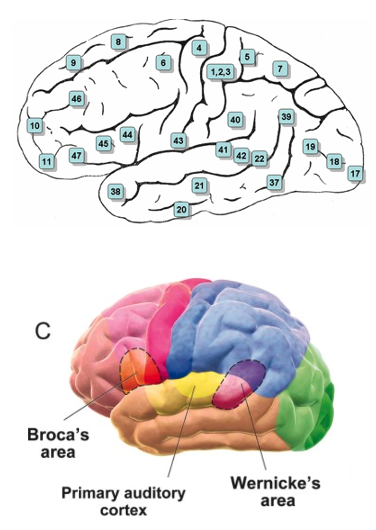
auditory
22 = superior temporal gyrus
written
40 = supramarginal
39 = angular gyri
what is the broadmann’s area for wernicke area
wernicke area
_____________ associates auditory inpur with memories to allow comprehension
44 and 45
what is the broadmann’s area for broca’s area
brocas area
____________ brings together information to begin process of creating motor production of speech
Primary auditory cortex
Wernicke area
Arcuate fasciculus
Broca area
Motor areas
5 areas with the ability to hear and repeat words
Temporoparietal
the ____________ area on the non-dominant hemisphere provides comprehension of speech
wernicke
the Temporoparietal on the non-dominant hemisphere is like ___________ area on the dominant hemisphere
broca
the inferior frontal on the non-dominant hemisphere is like ___________ area on the dominant hemisphere
inferior frontal
the ____________ area on the non-dominant hemisphere provides production of speech
decode non-standard meanings
process metaphors
understandthemes
besides comprehending and producing speech, what are the other functions of the non-dominant hemisphere concerning speech
superior division of the MCA
what is the vascular supply to brocas area
aphasia (difficulty turning concept or thought into meaningful sounds)
decreased fluency of spontaneous speech
often halting
short phrases (< 5 words)
content words (nouns > function words)
moste sever = mute
repetition and naming impaired
what can disruption to broca’s area casue
agraphia (inability to express thoughts in writing)
if there is aphasia with brocas area, it may be accompanied by ___________
inferior division of MCA
what is the vascular supply to wernickes area
wernikes
if a person’s speech is understandable but makes no sense, they have suffered an injury to the ___________ area
neologisms (injury to wernikes)
_____________ is defined as make up words
brocas
if the person is aware of the speech, they have suffered an injury to the ___________ area
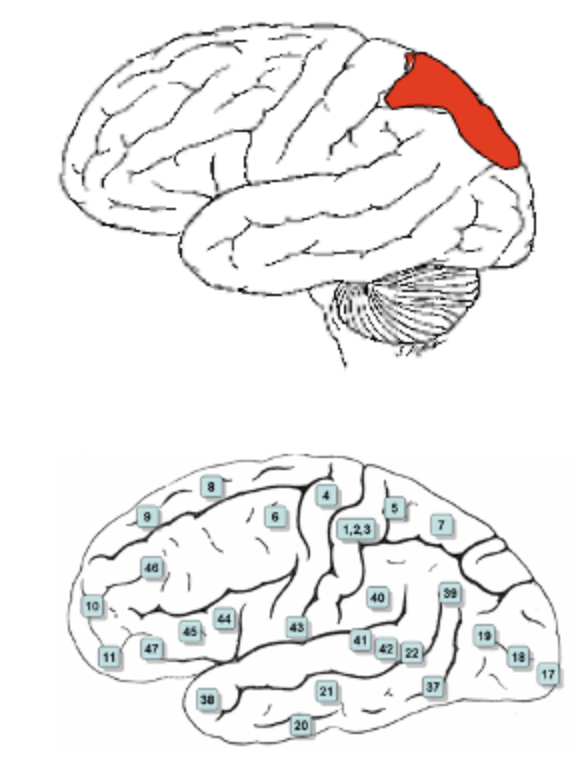
5 and 7
what is the broadmann’s area for the posterior parietal association cortex
non- dominant
a lesion to the posterior parietal association cortex would be most significant it is in the ______________ hemisphere
posterior partietal association
the _________________ area is for higher order processing (integrate sensory info, attention to spatial aspects of sensation, motor planning based on sensory input)
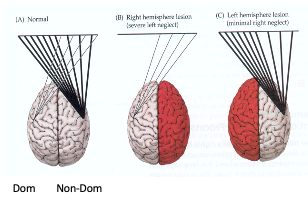
non dominant
dominant or non dominant:
more attention span
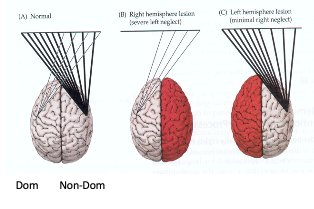
parietal
parietal or frontal:
more integrated sensory-spatial gestalt
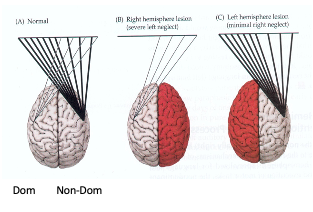
right
the dominant hemisphere responds to the….
left side
right side
both sides
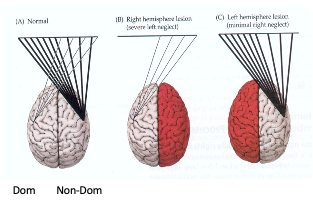
both (more stongly on the left)
the non dominant hemisphere responds to the….
left side
right side
both sides
non dominant
dominant or non dominant:
Difficulty with tasks requiring visual-spatial analysis
non dominant
dominant or non dominant:
hemi-neglect syndromes
non dominant
dominant or non dominant:
lesion would cause decrease in alertness and attention
non dominant
dominant or non dominant:
lesion would cause changes in personality/emotions
sensory (ignore visual, tactile, auditory)
motor-intentional (fewer movements on contralateral hemispace)
combined sensory and motor
conceptual (deny body part is theirs)
(remember this typically occurs on the right hemisphere/non dom side)
types of contralateral neglect (4)
agnosia (lesion of sensory association cortex, ex. put hand in pocket and know if it’s keys or coins)
____________ is the inability to recognize or interpret familiar objects, people, sounds, smells, or tastes despite having intact sensory functions